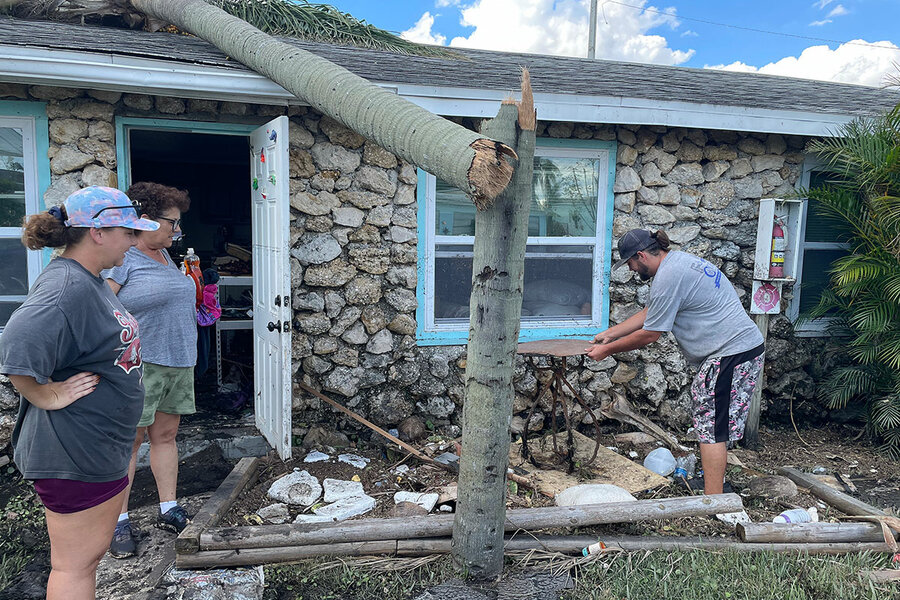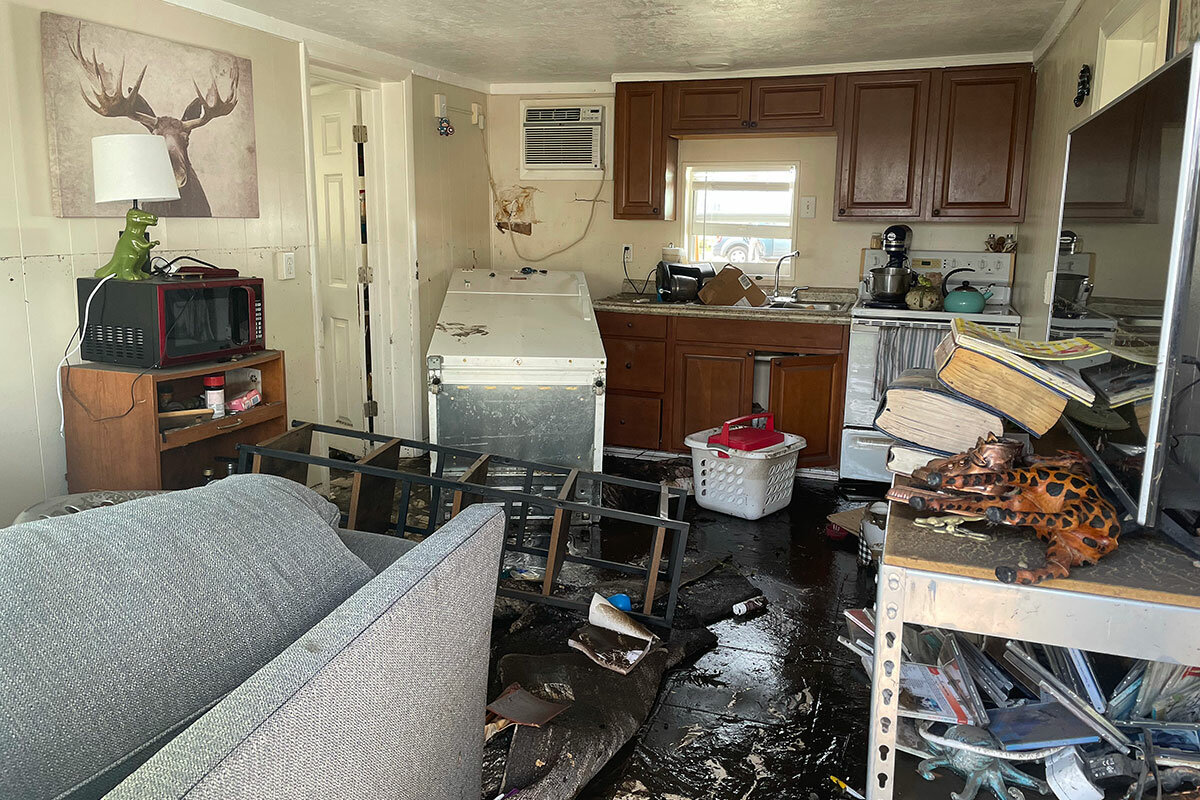Shaken but resilient, Florida residents move forward together after Ian
Loading...
| Fort Myers, Fla.
For Mindy Liepitz, it was just stuff in the end.
A two-inch layer of black mud lies between the bottom of her shoes and the floor of her modest two-bedroom rental home in North Fort Myers. Her furniture is waterlogged, ruined. The electronics throughout her home are lost – the computer, the refrigerator, the microwave, a funny Tyrannosaurus rex-shaped lamp she bought last week. Her car floated into the neighbor’s yard.
It can all be replaced, Ms. Liepitz says.
Why We Wrote This
A story focused onWith parts of Florida in physical tatters after Hurricane Ian, residents are relying on cooperation and compassion as they begin working as communities on recovery.
It didn’t feel like that last week, before Hurricane Ian, a Category 4, and its 150 mph winds veered south from its initial arc toward Tampa and made landfall in southwest Florida on Wednesday. Her possessions had helped define her. Just two months ago, Ms. Liepitz hauled everything she owned from Colorado to Fort Myers, following the same path as her daughter and son-in-law – Damie Liepitz and Kyle Collard – who purchased a houseboat on the marina and relocated last year.
“We sold my place and I moved down here and I set up my little world, never expecting a 500-year flood,” Ms. Liepitz says. “But in a way, it’s a fresh start for me. I’m really OK with it.”
She points to a watermark near the living room light switch. Ian’s surge resulted in more than 4 feet of water in her home. It was already pooling up to her ankles when she initially called her daughter and son-in-law to evacuate her to the condominium where they were waiting out the storm with neighbors. Within minutes, water had made it to her knees. By the time Mr. Collard arrived in his pickup, it had reached as high as Ms. Liepitz’s chest. Mr. Collard had to force his way through her front door as the storm’s surge lapped against it, holding it shut.
Ms. Liepitz stops in the middle of the room. She takes another long look around and walks back outside, where the sound of birds can be heard in the distance. It’s a warm autumn day.
Southwest Florida residents like Ms. Liepitz and her family are only beginning to find words in their reaction to Ian’s devastation across their region. As their surroundings lie in physical tatters, however, they are relying on cooperation and care for one another as they begin working as communities to persevere beyond the damage of a historic storm, while leaning on what remains.
“It’s hour by hour right now,” Mr. Collard says.
Prior to Ian’s landfall, roughly 2.5 million Floridians were issued evacuation orders. It was the largest temporary exodus the state has seen since prior to Hurricane Irma’s landfall in 2017, when by some estimates nearly 7 million Floridians evacuated.
Storm’s heavy toll
Those who opted to stay saw a storm surge inundate neighborhoods up to 12 miles inland, such as Ms. Liepitz’s in North Fort Myers. That was as areas across southwest Florida took on 10 inches or more of rain in a matter of hours. Deaths attributed to the storm were edging close to 100 by some counts on Monday, including four fatalities in North Carolina, where heavy rains followed a second landfall by Ian, in South Carolina, Friday morning. Federal officials estimated more than 4,000 emergency rescues occurred in Florida alone.
Early recovery estimates, putting damage at perhaps $100 billion, cite Ian as the costliest storm in the state’s history. The firm CoreLogic, which analyzes natural disaster costs, estimates between $28 billion and $47 billion in insured losses alone.
Between Ian’s Gulf and Atlantic coast landfalls, President Joe Biden declared a major disaster and pledged federal aid. He promised that the federal government will cover the full costs of search and rescue efforts and cleaning up debris and will help rebuild schools and infrastructure. He also offered financial assistance to residents with inadequate homeowner’s insurance.
As of this past weekend, work to restore the norm was well underway at the state level, too. Florida Power and Light, the state’s largest utility operator, had already restored power to about 1.5 million customers’ homes. At midday Monday, more than 300,000 households remained without electricity.
“This is how you do it”
Those still temporarily in the dark, like Phoebe Presson, a pastor at the St. Phillip CME Church in Fort Myers, began to take it on themselves to aid their friends and neighbors.
On Saturday afternoon, Ms. Presson helped organize supply distribution for the church members.
Ms. Presson only recently relocated to her new post in Fort Myers from Alabama after she was reassigned by a church leader. Ian was the first hurricane she’s witnessed in person, but she’s no stranger to the upheaval that comes after natural disasters. Before Ian last week, Ms. Presson had years of experience in helping administer disaster aid to communities following storms, like Hurricane Maria, which devastated the small island of Puerto Rico in 2018. To be on the opposite end of who’s receiving help, for Ms. Presson, is a humbling moment.
“I pretty much understood what I was getting ready to visualize,” Ms. Presson says of her mindset as she, like other residents who remained, stepped outside in the first light after Ian.
The questions have already begun to surface about whether state and local officials acted swiftly enough in ordering evacuations for residents in parts of southwest Florida – with some official evacuation orders handed down barely 24 hours prior to Ian’s landfall. But from the vantage of her community, Ms. Presson says she’s so far proud of the government response.
“Federal government, local government, and our community coming together – this is how you do it,” she says of how she’s seen others begin to rally around Fort Myers’ needs.
But Ian’s tests will continue for months and years into the future, she adds.
Fort Myers Beach, which is among the city’s economic lifelines as a tourism and nightlife destination, was razed in the storm. She understands that the city will take a hit as a result.
“It’s going to take some time,” she says. “But I do believe that we’ll be OK.”
For the Liepitz and Collard family, it was not only their first hurricane experience but also the first time to experience a community’s perseverance after a natural disaster.
“It’s really inspiring to see everybody come together the way that they always talk about on the news,” says the younger Ms. Liepitz, referring to the recent generosity of their neighbors, who have shared food and shelter. Together, they’ve siphoned gas from their flooded vehicles as a means of keeping the generator – which they are also sharing – functioning.
“You watch from 2,000 miles away and your heart breaks.” But, she adds, one can’t fully understand before living through both the storm and its aftermath as a community.
Getting out just in time
The water had already risen to past the bottom of his pickup truck’s doors by the time Mr. Collard made it to his mother-in-law’s home to rescue her. He’d traveled no more than a mile.
As they whipped out of her driveway back toward their temporary shelter, Mr. Collard looked at his mother-in-law and said, “You played that down,” referring to her home’s flooding.
“I know,” Ms. Liepitz remembers saying. She didn’t want to scare her daughter.
Behind them, they could see her car being pushed further down the street by the wake of his truck.
The most valuable of Ms. Liepitz’s possessions hadn’t even crossed her mind at that point. Instead, it was the silly, sentimental items she knew she would miss the most, like the ceramic octopus salt-and-pepper shaker she bought shortly after relocating to Fort Myers in July.
But there atop her stove’s control board sat the salt-and-pepper shaker, unscathed.
Seeing it, exactly where she left it, lifted her spirits.
Inside her wrecked home, Ms. Liepitz points to a pair of bronzed baby shoes sitting on a shelf near the broken TV. The shoes were hers as an infant; from place to place, across life, she’s carried them around for as long as she can remember. They’re ruined now. Ms. Liepitz doesn’t have to carry them anymore. She views the shoes as symbolic of the change occurring in her life.
Even after her move this past summer, Ms. Liepitz recalls feeling lost, despite a monthslong focus on relocating to Florida and starting her new life.
Ian changed everything, she says.
“There’s a piece of me that’s OK with throwing it all away,” she says of her possessions. The storm is propelling her headlong toward the new life she promised herself.






